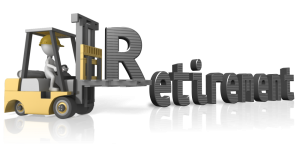Self-Employed Retirement Planning
 If you are successfully self-employed, or you are the owner-employee of a successful small business, most of the financial news you see doesn’t speak about self-employed retirement planning.
If you are successfully self-employed, or you are the owner-employee of a successful small business, most of the financial news you see doesn’t speak about self-employed retirement planning.
For example, there’s a lot of information out there about how a straight W-2 employee can make use of his or her employer’s Traditional 401(k) plan. But there’s not much out there about self-employed retirement planning such as how to design a Solo 401(k) plan for yourself, or whether you could be better off with something like a SEP, or Simplified Employee Pension plan.
Taking Charge
For those of you who are in charge of your own financial destiny, and who have not hitched their stars to an outside employer, understanding self-employed retirement planning is critical. You can’t rely on anyone else to take care of your retirement security. Unfortunately, according to a recent industry survey, some 28 percent self-employed individuals aren’t saving for retirement at all.
Nobody is going to do it for you. With that in mind, you will want to take advantage of every quirk the law allows to help you amass your retirement nest egg, and protect it from predators. Here are some principles to keep in mind.
- Use tax leverage. Accounts grow faster if the tax man leaves them intact, as opposed to levying a current tax on every dividend, every dollar of interest received, and on ever dollar of profit from trading. Retirement accounts like IRAs, Roth IRAs, Solo 401(k)s, Traditional 401(k)s, SEPs and SIMPLES let your money grow tax deferred, or in the case of Roth accounts, tax-free.
- Protect assets from lawsuits. Trial lawyers go after businesses all the time, for both good reasons and on trumped-up pretenses. They also go after business owners, personally. But money you can keep outside of your business, and in a retirement account, is largely off the table for collections. Specific laws vary by state, but federal law gives a great deal of protection to funds in Traditional 401(k)s and Solo 401(k)s and other pension plans and in IRAs.
- Leverage your expertise. You’re in business, or you’re self-employed because you’re good at something. You are probably an expert in something you can leverage, even within your IRA or other retirement account. That’s where we have some good news: Retirement accounts aren’t limited to mutual funds, annuities, CDs and money markets. You can invest in nearly anything you can imagine except life insurance, gems, jewelry, art, collectibles and alcoholic beverages – through an increasingly popular option called self-direction.
- Put lots away. As long as you have sufficient cash on hand to meet your immediate business needs, and accomplish your long term business strategy and lifestyle goals, the more money you can take out of your business and out of your personal name and move into protected retirement accounts, the better.
- Combine multiple types of accounts. For example, combine Roth and tax-deferred accounts to hedge against changes in tax rates in the future. Take advantage of more liberal hardship withdrawal terms in IRAs but also take as much advantage as you can of the bigger contribution ceilings on Traditional 401(k)s, Solo 401(k)s and SEPs.
Your Options
When it comes to self-employed retirement planning, you have several – the best one for you depends on your circumstances, including the amount you can contribute and what percentage of your income is salary versus Schedule C or dividend income.
The IRA – You get a tax deduction, and you can contribute up to $5,500 per year, or $6,500 if you are age 50 or over. Taxes are deferred until you take the money out. You also have a 10 percent penalty on most non-hardship withdrawals prior to age 59½. Beware: Once you turn 70 ½, you must begin taking money out by the following April 1, or you will face some harsh tax penalties. Your deduction may be limited if your income is high, or if you are covered by another retirement plan at work.
The Roth IRA – Similar rules to the IRA, except there’s no tax deduction. Instead, your investment grows tax-free after that, as long as you leave the money in it at least 5 years. There’s still a 10 percent penalty on the growth if you withdraw money prior to age 59 ½, unless certain hardship conditions apply.
Both versions of the IRA lend themselves easily to self-direction.
The Solo 401(k) – This is a 401(k) plan specially designed for the self-employed or ultra-small business owner. Fees and administration requirements are stripped down, but you can still contribute up to 20 percent of your net self-employment income plus $17,500, up to $52,000 in 2014, when you combine employer and employee contributions. Those age 50 or older can put in up to $5,500 more on an annual basis. This makes the Solo 401(k) an attractive option for those with relatively high incomes who are working on self-employed retirement planning.
Solo 401(k) plans lend themselves well to self-direction, and you can set them up to allow for loans from within the plan if you should so choose. Solo 401(k)s also tend to work well for self-directed investing strategies that involve leverage, such as real estate, because 401(k)s are exempt from unrelated debt-financed income tax rules that apply to IRAs.
You can also select Roth tax treatment for your Solo 401(k) plan, if you choose.
The SEP IRA – The SEP IRA also allows you to set aside up to $52,000 in 2014, or 25 percent of self-employment compensation – whichever is less. You have more flexibility if you have no employees – if you do have full-time employees you will likely have to fund their accounts with matching funds on the same basis that you match your own contributions with company money.
The SEP IRA is a great option for self-employed retirement planning because of the large annual contribution limit, and because of the relative ease of setup and low ongoing administration costs.
The SEP IRA also is compatible with self-direction.
Want to learn more? Stay tuned to this blog! Or better yet, visit our library at www.AmericanIRA.com, or call us at 866-7500-IRA (472). We are one of America’s leading experts on self-directed retirement investing and work with clients all over the country.
We look forward to serving you.
Image by: presentermedia.com


